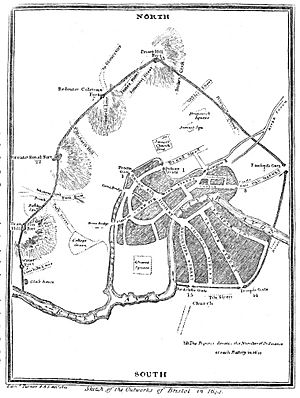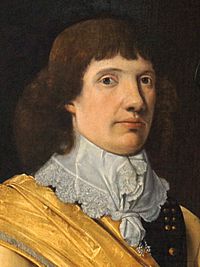Bristol in the English Civil War facts for kids
During the English Civil War (1642–1651), Bristol was a very important port city on England's west coast. Both the King's supporters (called Royalists) and the Parliament's supporters (called Parliamentarians) wanted to control it.
At first, Bristol's leaders wanted the city to stay out of the fighting. In 1642, city officials asked Thomas Essex not to bring his Parliamentarian soldiers into Bristol. But the city wasn't well-defended, so Essex entered easily. During the war, Royalists used Bristol to receive extra soldiers from Ireland. The city was well-protected by the River Frome and River Avon. It also had an old medieval castle, which the city had bought when the war began. The Parliamentarians also built forts made of earth for their cannons.
Even though Bristol was a big and rich port, it didn't play as big a role as some expected. Most people in Bristol weren't very excited about the war or the reasons for fighting.
Royal Fort House was later built where some important forts used to be. These forts were fought over during the war. This was the strongest part of Bristol's defenses. It was designed by a Dutch engineer named Sir Bernard de Gomme. This fort was one of the few defenses built specifically for the war. It was meant to be the main base for the Royalist army in the west, led by Prince Rupert. The fort was torn down in 1655.
For Bristol, the biggest event of the war was when Royalist forces attacked and took the city in 1643. This event is known as the Storming of Bristol. The Royalists lost many soldiers, especially their commanders, during this attack. After they captured Bristol, it became a key supply base for the Royalists. It was also a center for messages, management, and making weapons. The Royalists needed help from other countries and had to bring in weapons by ship. These ships had to avoid Parliamentarian patrols to deliver their goods to Bristol.
There's a common story about Bristol's capture by Prince Rupert in July 1643. The story often says that a huge Royalist army of up to 20,000 men attacked. It also claims that William Waller had carelessly left only 1,500 foot soldiers and 300 mounted troops to defend the city. This wasn't enough to guard all the defenses around Bristol. The story also says the defenses were weak and there wasn't enough ammunition. Despite these problems, the Royalists supposedly broke through by chance, finding a weak spot the defenders didn't know about. Once they broke through, the city was seen as impossible to defend. The commander, Nathaniel Fiennes, surrendered to save his soldiers and the people of the city. Even though this story was shown to be wrong soon after the event, some people still believe it.
Here are the main events that happened in or affected Bristol during the English Civil War.
Bristol in 1642
- February: Sir Baynham Throckmorton delivered a message from the King to Bristol's city council.
- February: The Mayor of Bristol sent cannons to Marlborough to be used against the King.
- July: The Marquis Hertford arrived in Somerset.
- September: Aldworth was chosen as Mayor.
- 23 October: The Battle of Edgehill took place.
- 2 December: Colonel Thomas Essex's two Parliamentarian regiments were allowed into Bristol.
- 10 December: A message from Bristol told Parliament that Colonel Essex and 2,000 men were in the city. Parliament then sent a letter to the citizens, encouraging them to keep defending Bristol.
Bristol in 1643
- 7 January: A request for peace was given to the King.
- 27 February: Colonel Nathaniel Fiennes took over from Colonel Essex as the Parliamentarian military Governor.
- March: The King's announcement about the Navy was sent to Bristol.
- April: Supplies were sent from Bristol to Protestants in Ireland.
- 30 May: Robert Yeamans and George Boucher were executed. They had been part of a secret plan to let Royalist forces into the city.
- 26 July: Bristol was stormed by Prince Rupert. (Fiennes later said this happened on August 5th). Rupert's force had about 15,000 men. They faced about 2,000 Parliamentarian defenders led by Fiennes. Many Bristol citizens also volunteered to help defend the city. The Royalists lost many soldiers attacking the cannon fort, possibly a third of their army. Even with heavy losses, Fiennes surrendered quickly after the city's defenses were broken. The Royalist forces looted the city. They also captured eight armed merchant ships, which became the start of the Royalist fleet. Workshops in Bristol became arms factories, making muskets for the Royalist army.
- Fiennes surrendered to Rupert. Because of this, he was put on trial by a military court, found guilty, and sentenced to death. His accusers in Parliament claimed his surrender was not necessary. However, he was saved by the Earl of Essex.
- After Bristol fell, the King moved his naval ships from ports in south Cornwall to Bristol. This force had 18 armed ships and was led by Sir John Pennington. The force was not well-trained or equipped, and many crews soon joined the Parliamentarians.
Bristol in 1644
- 5 January: The agreement for Devon and Cornwall was printed in Bristol by the King's Printer.
- Late January: About 1,500 Irish soldiers, led by Lord Inchiquin and "Great O'Niel," arrived in Bristol by ship. They were there to serve in the Royal army.
- December: The building of the Royal Fort was finally finished. This was a great relief for the many workers who had been forced to build it.
Bristol in 1645
In the summer of 1645, Royalist forces were defeated by the New Model Army at the Battle of Langport in Somerset. After more victories at Bridgwater and Sherborne, Sir Thomas Fairfax marched towards Bristol. Prince Rupert returned to organize the city's defense. The Parliamentarian forces surrounded the city. After three weeks, they attacked, eventually forcing Rupert to surrender on September 10th.
- 11 September: The city surrendered to General Thomas Fairfax. This happened after the second Siege of Bristol ended.
- September: Rupert reported this to King Charles and left England in disgrace.
- 7 January: The Council ordered a new assessment of citizens. Following the King's demands, they increased the weekly payment for supporting the soldiers from £100 to £150. However, they stopped the tax for building fortifications.
- Early March 1645: The Prince of Wales, who was under 15 years old, arrived in Bristol. He had been named General of the Association of the four Western counties. He was joined by Lord Capel, Sir Edward Hyde, Sir John Culpepper, and others who were chosen to be his advisors.




